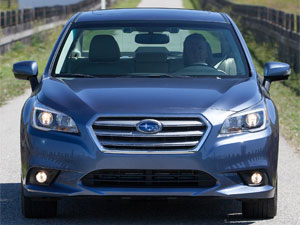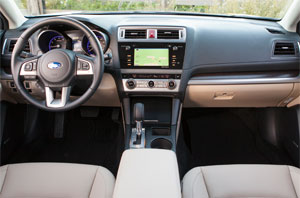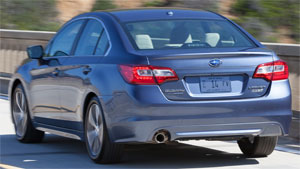2015 Subaru Legacy
The Subaru Legacy has been around long enough to actually have a legacy. That’s 26 years and counting as a comfortable, affordable, reliable family sedan choice. It’s also mirrored the legacy of the Subaru brand itself: delivering all-weather capabilities in a slightly quirky package. Well, an all-new Legacy is looking to update both histories, while also going a bit more mainstream.
The Subaru Legacy sedan has always labored in the popularity shadow of the Outback Sport Utility Wagon with which it once again shares a platform. So, what does the 2015 Legacy bring to the table to warrant more of the spotlight?
Well, for one thing, smoother, more mainstream styling. It looks like Subaru is taking a page out of the Honda Accord book by making the Legacy silkier, if also more conservative.
And that’s OK if, like the Accord, you design the car to be appealing as an entire package, and not just a shiny object of great desire that lacks good practicality and purpose. And, without a doubt, the Legacy has come a long way towards becoming that type of very desirable car.
 And perhaps that’s why they didn’t stretch too much on the powertrains as both engines carry over from last year. The 2.5-liter flat-4 sees a minor 2-horsepower gain to 175, and will still be the choice for most buyers. Our car’s very robust 3.6-liter flat-6 carries over unchanged with 256-horsepower and 247 lb-ft. of torque
And perhaps that’s why they didn’t stretch too much on the powertrains as both engines carry over from last year. The 2.5-liter flat-4 sees a minor 2-horsepower gain to 175, and will still be the choice for most buyers. Our car’s very robust 3.6-liter flat-6 carries over unchanged with 256-horsepower and 247 lb-ft. of torque
No manual or traditional automatics are offered, as a CVT is the only transmission. And it works surprisingly well this go around, being smoother with fewer…quirks!
Plus, it has helped raise the 6’s fuel economy numbers, though they still aren’t stellar; perhaps that‘s because all-wheel-drive is still standard. Government Fuel Economy Ratings are 20-City, 29-Highway, and 23-Combined for the six. We averaged 25.5 miles-per-gallon of Regular in a mixed loop of driving. If you don’t mind sluggish acceleration the 2.5 four has 30% better fuel economy.
At our test track, Subaru’s CVT performed quite well when combined with our snappy 3.6-six. The simulated shifting was strong and accompanied by a nice surge of power as the RPMs dipped ever so slightly. 0 to 60 was dispatched in a reasonable 7.3 seconds, and we ended the quarter-mile in 15.7-seconds at 92 miles-per-hour.
A much stiffer chassis and some honest to goodness heft to the wheel helps the Legacy also perform with more composure and sportiness than most rivals. Things are way more fun to drive than last year, with a definite hike in chassis feedback, and an overall demeanor that’s more Mazda6 than Camry.
Steering is quick and precise for both inputs and corrections, and handling prowess is aided by brake intervention Active Torque Vectoring. Overall braking performance fell back to about average, however, with some minor fade. Stops of 125-feet from 60 were smooth and straight.
 Things are well above average inside, particularly in Limited trim……and now we pause from this road test to say thank you, thank you, thank you to Subaru for finally putting in a non-frustrating navigation system. With this latest infotainment system, they’ve went from absolutely one of the worst units to one of the best.
Things are well above average inside, particularly in Limited trim……and now we pause from this road test to say thank you, thank you, thank you to Subaru for finally putting in a non-frustrating navigation system. With this latest infotainment system, they’ve went from absolutely one of the worst units to one of the best.
Everything is clear, the colors really pop, and the street names are highly legible. Even the variable touch buttons work well. It’s a huge improvement both visually and functionally, and as much grief as we’ve given them over the years, we’d better spend some time praising, now that they’ve gotten it right.
Gauges are also both more informative and clearer, and again, thank you Subaru, for bringing back a real coolant temperature gauge. A backup camera is now standard on all Legacy’s too, but the feature packed Limited also gets leather heated seating front and rear, a 576-watt Harmon Kardon audio system, and blind spot detection.
Seats all-around deliver great comfort and most interior measurements are up just slightly; even trunk capacity climbs a little to 15.0 cubic-ft before you fold the split rear seats.
 Legacy base pricing also climbs slightly to $22,490 for the 2.5i. The 3.6R comes in top tier Limited trim only, and stickers for $30,390.
Legacy base pricing also climbs slightly to $22,490 for the 2.5i. The 3.6R comes in top tier Limited trim only, and stickers for $30,390.
It’s clear to us that Subaru has listened to current owners and changed only what needed to be changed. The new Legacy may be less quirky, but in it stead is a high quality car that’s not nearly as sedate as it looks. Plus, even though it’s more mainstream, it still offers standard all-wheel drive, something still unique to the affordable mid-size family sedan segment. The 2015 Subaru Legacy deserves it’s time in the spotlight. We’re very favorably impressed with the result.
Specifications
- Horsepower: 256
- Engine: 3.6 liter
- Torque: 247 lb-ft.
- 0-60 mph: 7.3 seconds
- 1/4 mile: 15.7 seconds @ 92 mph
- EPA: 20 mpg city/ 29 mpg highway
2025 Volkswagen ID. Buzz
Volkswagen Brings Beetlemania Level Of Excitement To Minivan Segment
The duty of upholding Volkswagen’s heritage has most recently been delegated to small legacy car names like Golf and Jetta. But hold on! A much larger, totally modern take on VW’s classic microbus has just buzzed over the horizon— the all-electric ID. Buzz. It’s been at the top of our minds since we first saw the concept back in 2017. Well, it’s finally here, so let’s get our groove into drive!
This 2025 Volkswagen ID. Buzz has indeed created the most buzz around Volkswagen since the Beetle’s return to the U.S. in the late 1990s. We couldn’t drive it anywhere without drawing a crowd. No wonder, just about everyone has a VW Microbus story to tell, and seeing this reimagined version rolling down the street brings back all those memories.
VW really pulled it off as far as we’re concerned, as it looks great without appearing over the top. All the cues are here: Big VW logo front and center, lots of greenhouse including A-pillar windows and mini sliders for the second-row passengers, D-pillar air vents, and two-tone wheels. And while its appearance may be pure retro, its drivetrain is far from it, as the ID. Buzz is all-electric, and unlike the new Beetle, the Buzz does retain the original Microbus’ rear-drive architecture.
Powering those rear wheels is a 210-kW motor drawing juice from a 91-kWh battery for a range of 234 miles; 200-kW max charging will get you to 80% in about 26 minutes. Buyers can add another small 80-kW motor up front for 4motion all-wheel-drive and an increase of total output from 282 to 335 horsepower with a combined 512 lb-ft of torque. It uses the same battery, but range estimates drop just slightly to 231 miles. But while those numbers are modest, we also found them to be quite conservative, as we observed as many as 287 miles available in our all-wheel-drive tester’s gauge display and were on pace for 273 miles in our driving loop.
One throwback theme that may be a turnoff to some is that it’s quite a step up into the Buzz’s front seats, but there’s certainly a commanding view of the road once you climb in. Second row seating can be either a three-place bench or a pair of captain’s chairs, so there’s generous room for seven or six passengers. The captain’s chairs in our Pro S Plus offer good support and very easy access to the third row.
Lots of flexibility too with the option to simply fold the seats or remove them altogether.
With the sliding side doors and a wide opening rear hatch, there’s plenty of access for loading big sport utility amounts of cargo. Lots of flexibility too with the option to simply fold the seats or remove them altogether, and the ability to create a full-length flat floor with a rear cargo shelf that covers some handy removable storage bins. There’s 18.6 cubic-feet of space behind the third row, 75.5 behind the second, and a max of 145.5. That’s more than a Chevrolet Tahoe. For smaller items, there are lots of cubbies throughout the cabin, along with a standard Buzz Box that can be moved to multiple locations.
With a design that prioritizes retro form and modern function over aero efficiency, the 4motion equipped ID. Buzz earns a Fair efficiency rating, using 42-kWh of electricity per 100 miles, and we weren’t sure what to expect at our Mason Dixon test track.
What we found was great torque off the line and drama free launches to 60 in just 5.3 seconds. It was very stable at speed and power delivery stayed steady most of the way down the track until we reached about 90 mph, when it began to taper off just before we finished the quarter-mile in 14.0 seconds flat at 97 mph.
With 1,200-lbs. of battery weight nestled in its 127.5-inch wheelbase, the Buzz felt planted to the pavement through our handling course. There was quite a bit of body roll to deal with, but surprisingly little understeer. In panic braking runs, pedal response was inconsistent, feeling soft at times, pushing back hard at others; but through it all, results were quite good, stopping from 60 in an average of just 108 feet.
Three interior themes are available, this Dune is the brightest, featuring coastal inspired wood optic dash décor, “gray and clay” leatherette surfaces, and a high-mounted central 12.9-inch touchscreen. Pricing starts with a rear-wheel-drive Pro S at $61,545; this Pro S Plus begins at $65,045, add another $4,500 for 4motion, which brings a few extra features along with all-wheel drive.
Retro design with old-school VW charm, modern EV drivetrain, big SUV capacity merged with minivan flexibility; it all comes together in this 2025 Volkswagen ID. Buzz. It’s easily one of the coolest rides of the year and one that will likely keep Volkswagen dealers buzzing for years to come, and that’s something no other people and things mover can say.
Specifications
As Tested
- Motor Setup: Dual-Motor AWD
- Battery Size: 91-kWh
- Horsepower: 335
- Torque: 512 lb-ft
- EPA Range: 231 miles
- 0-60 mph: 5.3 seconds
- 1/4 Mile: 14.0 seconds at 97 mph
- Braking, 60-0: 108 feet
- MW Test Loop: ~ 273 miles













































